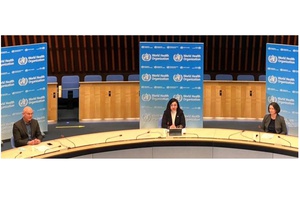COVID-19 highlights urgent need to reboot global effort to end TB
An estimated 1.4 million fewer people received care for TB in 2020 than in 2019 - a reduction of 21% from 2019, according to preliminary data compiled by the World Health Organization.
22 March 2021 - Geneva | An estimated 1.4 million fewer
people received care for tuberculosis (TB) in 2020 than in 2019,
according to
preliminary data
compiled by the World Health Organization (WHO) from over 80
countries - a reduction of 21% from 2019. The countries with the
biggest relative gaps were Indonesia (42%), South Africa (41%),
Philippines (37%) and India (25%).
“The effects of COVID-19 go far beyond the death and
disease caused by the virus itself. The disruption to essential
services for people with TB is just one tragic example of the
ways the pandemic is disproportionately affecting some of the
world’s poorest people, who were already at higher risk
for TB,” said Dr Tedros Adhanom Ghebreyesus, WHO
Director-General. “These sobering data point to the need
for countries to make universal health coverage a key priority
as they respond to and recover from the pandemic, to ensure
access to essential services for TB and all diseases.”
Building up health systems so everyone can get the services they
need is key. Some countries have already taken steps to mitigate
the impact of COVID-19 on service delivery, by strengthening
infection control; expanding use of digital technologies to
provide remote advice and support, and providing home-based TB
prevention and care.
But many people who have TB are unable to access the care they
need. WHO fears that over half a million more people may have
died from TB in 2020, simply because they were unable to obtain
a diagnosis.
This is not a new problem: before COVID-19 struck, the gap
between the estimated number of people developing TB each year
and the annual number of people officially reported as diagnosed
with TB was about 3 million. The pandemic has greatly
exacerbated the situation.
One way to address this is through restored and improved TB
screening to rapidly identify people with TB infection or TB
disease. New guidance
issued by WHO on World TB Day aims to help countries identify
the specific needs of communities, the populations at highest
risk of TB, and the locations most affected to ensure people can
access the most appropriate prevention and care services. This
can be achieved through a more systematic use of screening
approaches that employ novel tools.
These include the use of molecular rapid diagnostic tests, the
use of computer-aided detection to interpret chest radiography
and the use of a wider range of approaches for screening people
living with HIV for TB. The recommendations are accompanied by
an
operational guide
to facilitate roll-out.
But this will not be enough alone. In 2020, in his
report to the United Nations General Assembly, the UN Secretary General issued a set of 10 priority
recommendations that countries need to follow. These include
activating high-level leadership and action across multiple
sectors to urgently reduce TB deaths; increasing funding;
advancing universal health coverage for TB prevention and care;
addressing drug resistance, promoting human rights and
intensifying TB research.
And critically, it will be vital to reduce health inequities.
“For centuries, people with TB have been among the most
marginalized and vulnerable. COVID-19 has intensified the
disparities in living conditions and ability to access services
both within and between countries,” says Dr Tereza
Kasaeva, Director of WHO’s Global TB Programme. “We
must now make a renewed effort to work together to ensure that
TB programmes are strong enough to deliver during any future
emergency – and look for innovative ways to do
this.”
Note to editors:
World TB Day
is observed on 24 March each year to raise awareness and
understanding about one of the world’s top infectious
killers and catalyze action to address its devastating health,
social, and economic impact around the world.
Source:
World Health Organization


